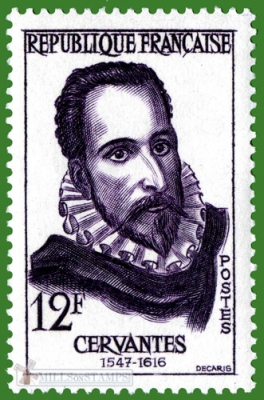-

Number by catalogue: Michel: 1169 Yvert: 1134 Scott: 859
Perforation type: 13x13
Subject:
12 francs. The portrait of Miguel de Cervantes Saavedra*
Additional:
*Miguel de Cervantes Saavedra,spanish novelist, playwright, and poet, the creator of Don Quixote, the most famous figure in Spanish literature. Although Cervantes' reputation rests almost entirely on his portrait of the knight of La Mancha, El ingenioso hidalgo, his literary production was considerable. William Shakespeare, Cervantes' great contemporary, had evidently read Don Quixote, but it is most unlike that Cervantes had ever heard of Shakespeare. In spite of his fame, Cervantes remained a poor man.
For if he like a madman lived,
At least he like wise old died.
(Don Quixote epitaph)
Miguel de Cervantes Saavedra lived an unsettled life of hardship and adventure. He was born in Alcalá de Henares, a small town near Madrid, into a family of the minor nobility. His mother was Leonor de Cortinas; she gave birth to seven children, Cervantes was the fourth. Rodrigo de Cervantes, his father, was an apothecary-surgeon. It has been argued that the family members were of converso origin, Jews who had converted to Christianity. Jews also appear as characters in several of Cervantes' plays and novelas.
Much of his childhood Cervantes spent moving from town to town while his father sought work. After studying in Madrid (1568-69), where his teacher was the humanist Juan López de Hoyos, he went to Rome in the service of Guilio Acquavita, who became a cardinal in 1570. In the same year Cervantes joined a Spanish regiment in Naples. He took part in the sea battle at Lepanto (1571), during which he received a wound that permanently maimed his left hand. Cervantes was extremely proud of his role in the famous victory and of the nickname he earned, el manco de Lepanto (the cripple of Lepanto). After recuperation in Messina, Sicily, he continued his military career.
In 1575 he set out with his brother Rodrigo on the galley El Sol for Spain. The ship was captured by pirates under Arnaute Mami and the brothers were taken to Algiers as slaves. Rodrigo was ransomed in 1577. The Moors though that Cervantes was more valuable captive because he had carried letters written by important persons. Cervantes spent five years as a slave until his family could raise enough money to pay his ransom. During this period he tried to escape several times without success. Cervantes was released in 1580, with the payment of 500 escudos raised by his family and the Trinitarian order. He returned to Madrid where he held several temporary, ill-paid administrative post. His first play, LOS TRATOS DE ARGEL (1580), was based on his experiences as a Moorish captive. In 1584 he married 18 years younger Catalina de Salazar y Palacios, the daughter of a well-to-do peasant. The marriage was childless. He had also a daughter, Isabel de Saavedra, from an affair he had with an actress, Ana Franca de Rojas (or Ana de Villafranca). Isabel worked as a servant in the family but her way of life caused him much worries. The other members of the household included his mother and two unmarried sisters.
In the late 1580s Cervantes left his wife. During the next 20 years he led a nomadic existence, also working as a purchasing agent for the Spanish Armada and a tax collector. He suffered a bankruptcy and was imprisoned at least twice (1597 and 1602) because of fiscal irregularities. It is generally believed that Cervantes was honest, but a victim of a thankless task. Between the years 1596 and 1600 he lived primarily in Seville, and by 1604 he had moved to Valladolid, where Philip III had established his court. In 1606 Cervantes settled permanently in Madrid, where he spent the rest of his life. His economic situation remained difficult. When a nobleman, Gaspar de Ezpeleta, was mortally wounded on the street in front of Cervantes' house, and died there, Cervantes and the women in his household were jailed on suspicion of having had something to do with his death. After one Alonso Fernandez de Avellaneda published a poor sequel to Don Quixote, Cervantes answered to the challenge and produced the second part, which appeared in 1615. He died on April 23, 1616. Three days before he had finished his novel The Exploits of Persiles and Sigismunda, dedicated to the Count of Lemos.
The information about Miguel de Cervantes Saavedra is from this site
Famous foreigners
France 1957.09.09
In issue: Stamp(s): 7
Printing: engraving